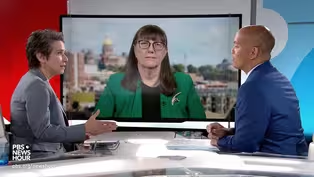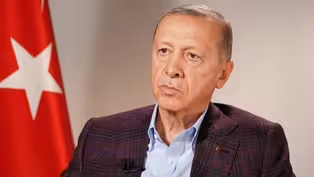
The pros and cons of stock markets for artwork
Clip: 9/18/2023 | 7m 45sVideo has Closed Captions
Is art a good investment? Experts weigh in on stock markets for artwork
The global art market totals nearly $70 billion, with returns in recent decades that outpace bonds, according to some estimates. That growth has spawned new investors looking to make some money in what is a booming sector. Economics correspondent Paul Solman looks at the prudence of investing in art, for our arts and culture series, CANVAS.
Problems playing video? | Closed Captioning Feedback
Problems playing video? | Closed Captioning Feedback
Major corporate funding for the PBS News Hour is provided by BDO, BNSF, Consumer Cellular, American Cruise Lines, and Raymond James. Funding for the PBS NewsHour Weekend is provided by...

The pros and cons of stock markets for artwork
Clip: 9/18/2023 | 7m 45sVideo has Closed Captions
The global art market totals nearly $70 billion, with returns in recent decades that outpace bonds, according to some estimates. That growth has spawned new investors looking to make some money in what is a booming sector. Economics correspondent Paul Solman looks at the prudence of investing in art, for our arts and culture series, CANVAS.
Problems playing video? | Closed Captioning Feedback
How to Watch PBS News Hour
PBS News Hour is available to stream on pbs.org and the free PBS App, available on iPhone, Apple TV, Android TV, Android smartphones, Amazon Fire TV, Amazon Fire Tablet, Roku, Samsung Smart TV, and Vizio.
Providing Support for PBS.org
Learn Moreabout PBS online sponsorshipAmna Nawaz: The global art market totals nearly $70 billion, with returns in recent decades that outpace bonds.
By some estimates, that growth has found new investors looking to make some money in what's now a booming sector.
Economics correspondent Paul Solman takes a look at the prudence of investing in art for our arts and culture series Canvas.
Paul Solman: The grand opening of ARTEX, a European art stock market, which plans to start trading soon, selling shares in art like this.
Francis Bacon One work at a time.
Yassir Benjelloun-Touimi, ARTEX: We are the equivalent of Nasdaq.
We love the New York Stock Exchange or the London Stock Exchange.
Paul Solman: Co-Founder and CEO Yassir Benjelloun-Touimi.
Yassir Benjelloun-Touimi: Instead of buying a corporate share in a company, you buy a share into a masterpiece.
Paul Solman: One of 550,000 shares in a triptych by the late English painter Francis Bacon of his lover George Dyer.
An IPO, a public offering with shares priced at $100 each.
And what do I get for that?
Yassir Benjelloun-Touimi: You get the appreciation in exact way.
You get the appreciation if you're buying an ounce of gold.
Paul Solman: What if Francis Bacon paintings are no longer popular.
Yassir Benjelloun-Touimi: When you buy share in Apple at any time?
Are you sure they're not going to lose value?
Paul Solman: Now Architects is the latest firm to sell shares in individual works of art, but not the first.
Kelly Crow, Wall Street Journal: In the past, collectors and dealers have often bought things in small consortiums.
Paul Solman: Wall Street Journal art market correspondent Kelly Crow.
Kelly Crow: The British Railway Pension did sort of pioneer this idea that you could pool your money and buy better things and hold it for a time and resell it.
Paul Solman: So somebody can buy a share of this is a Warhol or a reproduction of a world that you own.
But nowadays, New York's masterworks already sells art shares to the public, as you would stocks.
Chief Investment Officer Allen Sukholitsky.
Allen Sukholitsky, Masterworks: Masterworks is a firm that makes art and investable asset class.
The first firm that's ever done it, we started in 2017, so we've been doing it now for several years.
Paul Solman: During which the firm's value has climbed to more than $1,000,000,000, it says.
Employees beating the bushes for marketable high value artwork and customers to whom to hawk shares in a masterwork like an Andy Warhol or a Yayoi Kusama.
Allen Sukholitsky: I should actually about 100 years old, which is always interesting.
It tells you that artists have definitely cracked the code on living forever.
Paul Solman: Apparently the usual minimum investment $15,000 for shares of an artwork whose price is derived from an auction database tracking 7000 artists post-World War Two.
Masterworks says it only buys blue chips.
Artists like Warhol and Kusama, whose values have outperformed the stock and bond markets for the past 20 years.
And Shea cause supposedly masterwork backed securities.
So does this pose a threat to traditional sellers like Auction house Christie's, whose Giacometti transmogrified into a dig?
I had me flummoxed until learning they were holograms to be digitally shipped to potential buyers.
Bonnie Brennan: We really see it as an expansion of the market, and it's a it's an innovative way to to broaden our market.
Paul Solman: President for American Art Bonnie Brennan.
Bonnie Brennan, Christie's: If this is a way to meet new clients all the better for us.
Paul Solman: But better for everyone.
Well, as always, warns reporter Kelly Crowe.
Investor beware.
Kelly Crow: The art market is just super unregulated.
It's kind of like a wild West.
And if you want to buy $100 share just for kicks in the same way that you would go to a baseball game just to have fun and see how something does roll the dice, have some fun.
I just I would be a little nervous.
You know, taking out a second mortgage.
Paul Solman: Even for a painting is highly valued in the current market.
Is the Francis Bacon triptych.
Kelly Crow: These George Dyer Triptychs that sold in 2017 for mid 50 million are important because that lover eventually committed suicide on the eve of a major show of break ins.
We really love the soap opera of an artist's life and how that feeds into the work.
Alex Glauber, AWG Art Advisory: It's a word called hot pie, which simulates hot by sitting on on the kitchen window.
Cooling.
Paul Solman: Yeah, I see.
That's the.
That's the.
That's the steam from the hot pot.
Exactly.
Contemporary art consultant Alex Glauber, who helped his client by this work by Alex de Court.
Glauber has sold two masterworks, so an art stock market is a good thing?
Alex Glauber: Certainly brings more money and attention to the art market, but I don't know if it's necessarily healthy for art and the appreciation of art long term.
Paul Solman: Why not?
Alex Glauber: Why?
Because if the conversation is more about the money than the art that really devalues, it undermines the very purpose of art.
Paul Solman: But the argument is, I'll start out with it as an investment.
Then I'll get interested in it and I'll learn more about it.
I'll become an art appreciator.
Alex Glauber: But if what you're trying to learn about is why this is a savvy investment, why this artist is poised for an uptick in their value, that's very much at odds with what perhaps put that artist in that position in the first place.
Paul Solman: In other words, we're talking speculation, as in some 1000 Picasso's and innumerable other brand name works stored in warehouses around the world.
Or more recently, speculation in digital and nfts non-fungible tokens that boomed and then swooned.
Since I interviewed investor Lin Dai barely a year ago.
Okay, so what's happened to the NFT market since last we talked?
Alex Glauber: Yeah.
You know, there's a lot of have changed.
We saw this speculative bubble pop.
Paul Solman: Which had seen Lin Di's bored ape nft double in value to $400,000 before falling back down to around $100,000 today, by his estimate.
You have second thoughts?
Misgivings about having bought your board ape?
No, absolutely.
Yassir Benjelloun-Touimi: Not.
I think certainly the board probably well hold its value over time.
Paul Solman: Unlike, say, Yosef, Israel's pancake day, which fetched more than £1,000,000 in 1895.
A billion or more dollars today, depending on how you convert prices.
Israel's largest painting at auction in recent years brought $35,000.
Just one of countless examples that illustrate what philosopher Barbara Herrnstein Smith calls the contingencies of value.
Barbara Herrnstein Smith, Author: Value is not fixed, inherent objective and part of objects, but the product of numerous interactions between.
People and things in their universe.
It's contingent in the sense that what effects those interactions changes.
The question is always going to be will it continue to be valued over time?
Not will it continue to have value over time?
Paul Solman: And thus for the investment value of art, we've learned to prize from Leonardo and Rembrandt to Israel's Van Gogh and Picasso.
Bacon.
Warhol.
Kusama aboard eight.
Time will tell if we fickle mortals, will continue valuing them as we do today.
For the PBS NewsHour, Paul Solman, mostly in New York.
Amy Walter and Kay Henderson on the GOP impeachment inquiry
Video has Closed Captions
Clip: 9/18/2023 | 8m 25s | Amy Walter and Kay Henderson on voter reaction to the House impeachment inquiry (8m 25s)
Breaking down the U.S.-Iran deal that freed five Americans
Video has Closed Captions
Clip: 9/18/2023 | 6m 26s | Breaking down the U.S. deal with Iran that freed five Americans from captivity (6m 26s)
Five Americans fly home after years of imprisonment in Iran
Video has Closed Captions
Clip: 9/18/2023 | 10m 27s | Five released Americans fly home after years of imprisonment in Iran (10m 27s)
GOP presidential candidates court evangelical voters in Iowa
Video has Closed Captions
Clip: 9/18/2023 | 3m 13s | How GOP presidential candidates are courting evangelical voters in Iowa (3m 13s)
Turkey’s Erdogan says he trusts Russia as much as the West
Video has Closed Captions
Clip: 9/18/2023 | 12m 9s | Turkey’s Erdogan says he trusts Russia ‘just as much as I trust the West’ (12m 9s)
Providing Support for PBS.org
Learn Moreabout PBS online sponsorship
- News and Public Affairs

FRONTLINE is investigative journalism that questions, explains and changes our world.

- News and Public Affairs

Amanpour and Company features conversations with leaders and decision makers.












Support for PBS provided by:
Major corporate funding for the PBS News Hour is provided by BDO, BNSF, Consumer Cellular, American Cruise Lines, and Raymond James. Funding for the PBS NewsHour Weekend is provided by...




